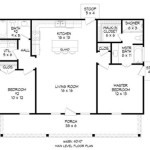How To Read Floor Plan
Floor plans are essential tools for architects, builders, and interior designers. They provide a detailed layout of a building, showing the arrangement of rooms, walls, doors, and windows. For homeowners, floor plans can be helpful for planning renovations, additions, or simply understanding the layout of their home.
Reading a floor plan can seem daunting at first, but with a little practice, it's relatively easy to understand. Here are a few tips to get you started:
- Start with the basics. The most important thing to understand is the scale of the floor plan. This will tell you how big the rooms are in relation to each other. The scale is usually indicated in the legend, which is a small box on the floor plan that shows the relationship between the drawing and the actual size of the building.
- Identify the rooms. The next step is to identify the different rooms in the floor plan. This can be done by looking at the labels, which are usually located next to each room. If there are no labels, you can try to guess the purpose of each room based on its size and shape.
- Pay attention to the walls. The walls are shown as lines on the floor plan. The thickness of the lines can tell you something about the type of wall. For example, thick lines usually indicate load-bearing walls, which are important for supporting the structure of the building.
- Look for doors and windows. Doors and windows are shown as symbols on the floor plan. The symbols can vary depending on the type of door or window, but they are usually easy to identify. Doors are typically shown as rectangles with a line through them, while windows are shown as squares or circles with lines inside them.
- Understand the dimensions. The dimensions of each room are usually indicated on the floor plan. This information can be helpful for planning furniture placement and other design decisions.
Once you understand the basics of floor plans, you can start to apply this knowledge to your own home. By studying the floor plan, you can get a better understanding of the layout of your home and how to make the most of the space you have.
Here are a few additional tips for reading floor plans:
- Use a ruler or tape measure to measure the dimensions of the rooms. This will give you a better idea of the actual size of each room.
- Take note of the location of doors and windows. This information can be helpful for planning furniture placement and traffic flow.
- Look for any special features or details on the floor plan. These could include things like fireplaces, built-in shelves, or walk-in closets.
With a little practice, you'll be able to read floor plans like a pro. This skill can be helpful for a variety of home projects, from planning renovations to simply understanding the layout of your home.

How To Read A Floor Plan With Dimensions Houseplans Blog Com

How To Properly Read Floor Plans And What Details Look For

How To Read A Floor Plan

How To Read Floor Plans 8 Key Elements A Plan Foyr

How To Read A Floor Plan With Dimensions Houseplans Blog Com

How To Read A Floor Plan With Dimensions Houseplans Blog Com

How To Read A Floor Plan With Dimensions Houseplans Blog Com

How To Read House Plans The Construction Set

Do You Know How To Read Floor Plans

How To Read Floor Plans With Dimensions A Guide








